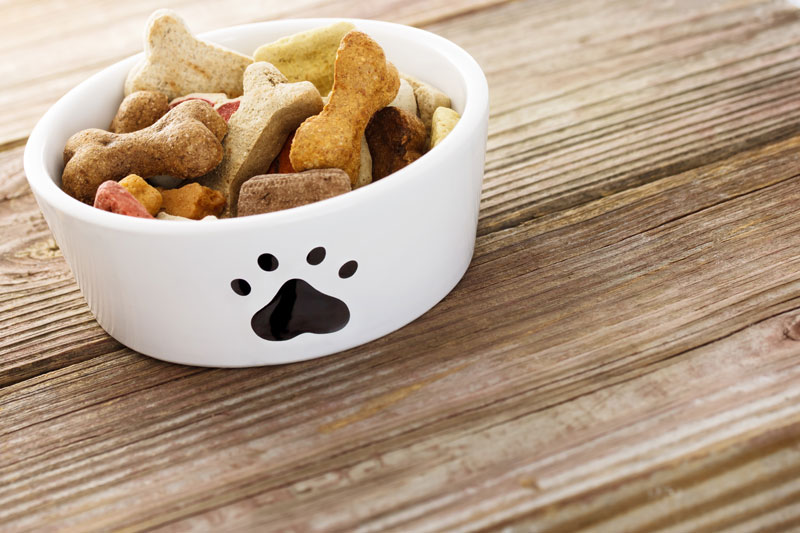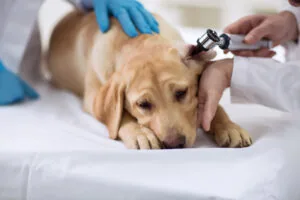Is it time to Change My Dogs Food?

Eating the right foods can actually go a long way to resolving or managing health issues. Although we wouldn’t recommend skipping a visit to the vet in favor of a sudden change in diet, certain health factors can and should influence what food your dog eats.
Diet and Life Stage
Dogs’ nutritional needs evolve as they age. Take protein as one example: Growing dogs need lots of it; adult dogs need less. In senior dogs, too much protein can harm the liver and kidneys. Fortunately, there is dog food out there for each life stage. A puppy formula will have enough protein (and carbohydrates) for the bright-eyed and bushy-tailed youngster, while adult and senior formulas have different balances of ingredients. Senior-dog food also may include supplements such as glucosamine and chondroitin, which may ease stiffness in your old buddy’s joints.
Health Conditions
Neutering
Although it isn’t a ‘health condition’ per se, neutering is a factor which influences how you should feed your pet. The process alters your dog’s hormonal balance quite profoundly, slowing down their metabolic rate. This means that they require fewer calories than their non-neutered counterparts. The effect is particularly noticeable in female pooches.
Pregnancy and Nursing
Like all mammals, dogs require extra calories during pregnancy and nursing. In the final weeks of pregnancy (6-9), mothers should be fed a higher energy food. Simply upping her intake of regular food is often not enough, since her stomach capacity is reduced by the presence of the puppies. To provide the calories she needs, you can feed a pregnant dog puppy food. Continue to feed her this food during nursing, and ensure she has constant access to water, as dehydration can stall milk production. Once her puppies have weaned, you can gradually restore her to her usual food.
Allergies and Intolerances
Food allergies and intolerances are surprisingly common among dogs. The most common trigger foods are:
- Beef
- Dairy
- Wheat or grains in general
- Egg
- Chicken
- Lamb
- Soy
Surprisingly, some breeds are more prone to allergies than others. If you own a boxer, spaniel, collie, retriever, or dachshund, allergies are more likely to occur. If your pooch is suffering from a food allergy or intolerance, you can expect to see the following symptoms:
- Vomiting
- Diarrhea
- Itchy skin
- Ear infections
If you suspect your dog is suffering from a food allergy or intolerance, check with your vet as soon as possible. Luckily, it’s fairly easy to find foods that avoid the ingredient your dog is allergic to. For allergy-prone dogs, it’s a good idea to choose a limited ingredient food, which helps you maintain better control of what they’re eating.
Skin and Coat Conditions
Minor skin conditions are one symptom of food allergies in dogs, so switching their diet can be a simple and effective way to resolve them. To promote a healthy coat in general, look out for foods containing omega-3 and 6 fatty acids (commonly found in fish oil), biotin, vitamin A, and Zinc.
Joint Problems
As mentioned earlier, many dogs – particularly seniors and larger breeds – are prone to joint problems. You should also bear in mind that joint problems can be exacerbated and even triggered by excess weight. To keep your dog’s joints in tip top condition, encourage regular exercise and avoid overfeeding.
Behavioral Problems
Certain behavioral issues can also be triggered by food. The artificial additives in some dog foods may be linked to hyperactivity – just like the link between junk food and hyperactive children. If your dog seems to be anxious or hyperactive, it’s a good idea to look out for a food which avoids using artificial colors, flavors, or preservatives in its recipe.
Urinary Problems
Your dog’s diet can also affect the health of their urinary tract. Urine is produced by the kidneys as they remove toxins from the blood, and one of these toxins, urea, makes a great snack for nasty bacteria. In other words, urine with a high urea concentration is more likely to trigger urinary tract infections. To help combat this, ensure your dog is always well-hydrated, since this helps to produce diluted urine, which is less infection-prone. Dogs with a particular weakness to urinary conditions may also benefit from a low protein diet, since urea is the product of protein digestion. If your dog is experiencing urinary problems, always consult your vet before you consider switching their diet. Low protein diets can be dangerous for some dogs, because they tend to result in lower muscle mass.
Obesity
It doesn’t take much for a pet to wind up with some extra weight on their frame — and this is particularly noticeable with small dogs. A diet specifically designated for weight loss will ensure that they still have the proper amount of essential nutrients, vitamins, and minerals while ingesting fewer calories. These diets take advantage of the latest research in pet weight management to ensure your dog is on their way to a healthier weight in no time! If your dog is extremely overweight or obese, however, it’s best that you consult with your veterinarian for a therapeutic nutritional solution.
GI Disturbances
Chronic flatulence, loose stool, or rumbly stomachs can be the result of food intolerance or the low quality of food that you’re feeding your pet. GI upset is an inconvenience to owners as well as being uncomfortable for your pet. Consult with your veterinarian as the solution may be as easy as switching to premium dog food or a sensitive stomach diet that’s right for your pet.
How to Change Your Dog’s Food
Maybe your veterinarian has recommended a prescription diet, or perhaps you’ve simply decided to try a new brand. Whatever the reason for the switch, changing your dog’s diet is more complex than simply pouring the new food into a bowl. In order to avoid upsetting your dog’s stomach, you will need to transition to the new food the right way. Here’s the best way to switch dog foods. Switching your dog’s food abruptly can cause gastrointestinal upset such as vomiting, diarrhea, and a decreased appetite. Any time you decide to change your dog’s food, you should transition to the new diet gradually in order to give your dog’s system time to adjust to the change. Ideally, these transitions should happen over 5-7 days. During this transition, you will gradually incorporate more and more of the new food by mixing it with your dog’s current diet. For most dogs, a good diet transition will look like this:
- Day 1: 25% new diet and 75% old diet.
- Day 3: 50% new diet and 50% old diet.
- Day 5: 75% new diet and 25% old diet.
- Day 7: 100% new diet.
Some dogs with sensitive stomachs, food allergies, or other gastrointestinal diseases may need an even longer transition period. The key to a good diet transition is monitoring your dog’s individual response. If, at any point during the diet transition, your dog displays concerning signs such as changes in appetite, vomiting, or diarrhea, you should proceed more slowly. And if you have transitioned gradually and your dog is still experiencing stomach upset, it is best to consult with your veterinarian. In some cases, it may be necessary to choose a different diet.
Share This Post
Recent Posts
About Shallowford Animal Hospital
Shallowford Animal Hospital and The Pet Spa at Shallowford are dedicated to the exceptional, compassionate care your pet deserves. Pets hold a very special place in our families, and we treat yours like our own.



